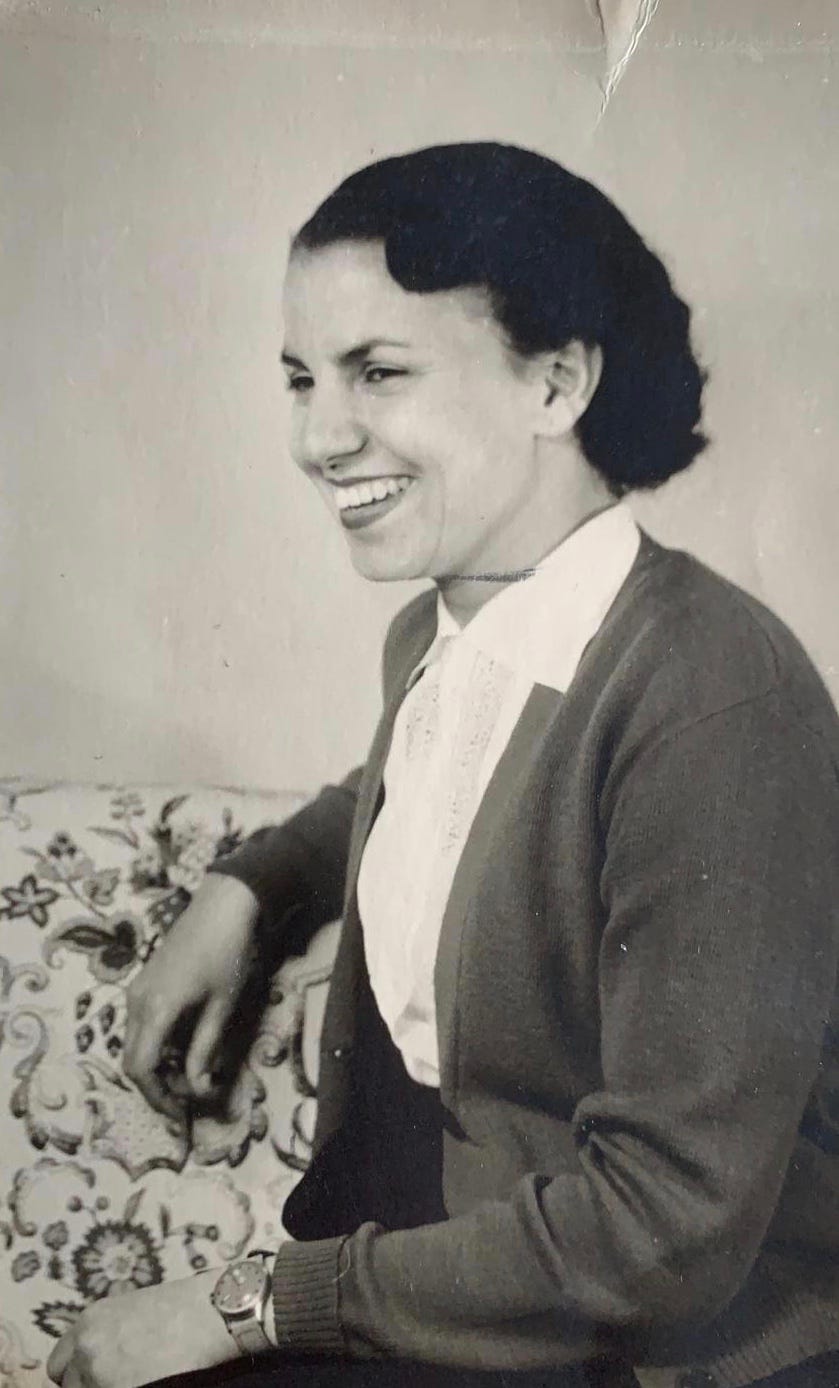Born in 1925 as the middle child in a family of seven sisters and two brothers, Menhat Allah Helmy stood out among her siblings through her artistic talent. She graduated with distinction from Cairo’s High Institute of Pedagogic Studies for Art in 1949 and earned her a government scholarship three years later—just months after the July 1952 military coup that overthrew Egypt’s monarchy—to continue her education at the prestigious Slade School of Fine Art in London.
During her three years at Slade, where she studied under the likes of world- renowned sculptor Henry Moore and others like Graham Sutherland and William Coldstream, Helmy focused on painting and graphic printmaking, eventually settling on etchings as her preferred medium. She began to experiment with different plates, using copper, zinc and wood to produce black-and-white prints that distinguished her work at a young age. She journeyed across England during her three years at Slade, exploring London’s parks, churches, and rivers, and traveling to places like the Isle of Wight and to small towns along the countryside. She carried a small sketchbook, which she used to lay the foundations for her later prints. Her dedication to the craft of printmaking did not go unnoticed, as the Egyptian artist—one of the first to attend the prestigious school—went on to win the Slade Prize for Etching in 1955.
Upon Helmy’s return to Egypt in 1955, she found her country engulfed in socio-economic upheaval, geopolitical tension, and revolutionary fervor. Armed with her newly developed skill in etching, she documented the societal changes taking place around her, including the Suez Canal crisis, the historic 1957 parliamentary election, and the building of the Aswan High Dam. In her work, she captured the country’s unseen majority: fishermen on the Nile, laborers in brick factories and animal markets, farmers working the fields. She was one of the first artists to capture the rapidly changing Egyptian State through the eyes of women—whether campaigning to vote, breastfeeding in newly erected outpatient clinics, or as prominent members of society working on par with their male counterparts.
Her work during this time cemented her reputation as a pioneer of Egyptian printmaking.
After establishing herself as an award-winning and acclaimed etcher both at home and on the international stage by the late 1960s, Helmy decided to pivot away from the black-and-white etchings that characterized her work, instead challenging herself to create powerful political paintings and abstract prints, the latter of which were ahead of their time in the Egyptian art scene. She returned to London in 1972—this time accompanied by her husband and two daughters, Nihal and Sara—and completed her pivot towards abstraction, and thus created some of the works that would become her signature pieces. Her black-and-white etchings were a thing of the past, replaced instead by conceptual graphics with complex geometric structures and bright colors inspired by her fascination with the universe, space exploration, technological advancements, and modern machinery.
By the early 1980s, however, Helmy’s lungs began to suffer after years of inhaling fumes from the printmaking process. Then, in 1988, her husband of more than thirty years passed away. Torn from the partner she cherished and deprived of the art that brought her the most joy, Helmy decided to retire. Her final print is dated 1983–a full twenty-one years before her own passing in 2004.
وُلدت منحة حلمي في حلوان بمصر في 11 يوليو 1925 كطفلة وسط عائلة مكونة من سبع شقيقات وشقيقين. تخرجت من المعهد العالي للدراسات التربوية للفنون بالقاهرة عام 1949 قبل أن تواصل تعليمها بالخارج في مدرسة سليد للفنون الجميلة بين عامي 1953 و1955، حيث ركزت على الرسم والفنون التشكيلية والتنميش. درست لاحقًا الرسومات الملونة في جامعة مورلي في لندن خلال إقامتها في لندن بين 1973-1979.
كانت منحة حلمي بجانب قامات مثل حسين الجبالي وعبدالله جوهر ومريم عبد العليم جزءًا من جيل رائد من الفنانين الذين لعبوا دورًا محوريًا في هذا المجال.[4] نالت رسومات حلمي بالأبيض والأسود استحسان النقاد بسبب تعقيدها، وكذلك لصعوبة إدراكها. كانت حلمي من أوائل الفنانين الذين نقشوا مشاهد كاملة في عملها، وكررت تأثيرات الرسومات التخطيطية ورسومات تفصيلية على الزنك قبل تحويلها إلى مطبوعات.
بعد فوزها بجائزة سليد للنقش عام 1955، شاركت منحة حلمي في المعارض حول العالم. شاركت في معظم المعارض المحلية في مصر من عام 1956 وما بعدها، كما أقامت أول معرض خاص لها في عام 1966. شاركت في العديد من مهرجانات الرسم الدولية في ألمانيا الغربية ويوغوسلافيا وبولندا وإيطاليا وطوكيو والهند. وفازت بجائزة صالون القاهرة عامي 1959 و1960، وجائزة معرض القاهرة للإنتاج عام 1957، وجائزة ليوبليانا الفخرية عام 1961. ذهبت حلمي لتصبح محاضرة في معهد الفنون الجميلة في القاهرة، وأستاذًا للفنون الجميلة بجامعة حلوان بالقاهرة، وأستاذًا فخريًا للنقش في أكاديمية الفنون الجميلة في فلورنسا بإيطاليا،[6] وعضوًا في مجلس صانعي الطباعة في المملكة المتحدة.
تقاعدت حلمي من الطباعة في الثمانينيات بسبب أحد أمراض الرئة بسبب المواد الكيميائية المستخدمة في رسوماتها، ولكنها واصلت التدريس في جامعة حلوان حتى وفاتها في عام 2004 عن عمر يناهز 78 عامًا.
تُعرض أعمال منحة حلمي في متحف الفنون الحديثة في مصر، كما توجد في مجموعات خاصة في مصر، وألمانيا، وبريطانيا، والإمارات العربية المتحدة، والولايات المتحدة.[5] تبرعت ابنتها سارة خلاف بإحدى رسوماتها التجريدية في صلب الموضوع To the Point لجامعة القاهرة . بيعت لوحتها موكب للعمل في دار كريستيز للمزادات في عام 2007. حصل سلطان سعود القاسمي من مؤسسة بارجيل للفنون على لوحتها التجريدية "استكشاف الفضاء" في عام 2019.
ًWhy should you subscribe to the newsletter?
This is a family-run newsletter managed by Helmy’s daughter, Sara, and her grandson, Karim. We hope to provide rare insight into the artist’s life, her remarkable oeuvre, and the various other facets of her archive.
Paid subscriptions will help our family continue to sustain Menhat Helmy’s legacy. If you can afford it, please consider subscribing here. Your contribution helps us cover the costs of managing the estate and allows us to continue sustaining this venture.



